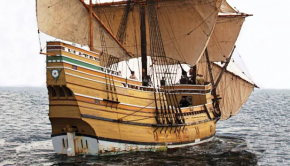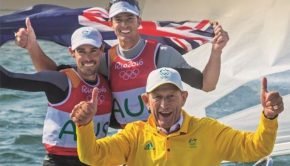Chronicling a Midlife Crisis
Published on April 16th, 2018
by Craig Leweck, Scuttlebutt
Long before he became one of our foremost historians and a New York Times bestselling author, Nathaniel Philbrick, at just 22-years-old, won the 1978 Sunfish North American Championship. But soon life got in the way and he’d lost touch with the sport he was so passionate about.
Then at 36 years of age, after his young children scolded him to “get a life”, he went about doing just that. Pulling out his old Sunfish with a goal of competing again in the 1993 North Americans, Nat chronicles how the experience impacted his family and himself in the book, SECOND WIND.
Originally published in 1999 by a small New England press, it has been re-released, and I really enjoyed following along with his utterly relatable experiences. I would recommend SECOND WIND for anyone who is now, or has been in Nat’s situation, or simply wonders about their connection to the sea.
Here’s more information about the book…
Can you tell us a little bit about the backstory behind SECOND WIND?
My wife Melissa and I moved to Nantucket Island with our two young children Jennie and Ethan in 1986. Melissa was a lawyer; I was a struggling writer and stay-at-home dad. I loved being with my kids all day, but my career had stalled and I had lost all touch with competitive sailing, the sport that had once meant everything to me.
And then, in the fall of 1992, when I was 36 years old, everything changed. Ethan started first grade, which meant I now had until 2:30 in the afternoon (an unheard of span of time) to write and I began work on my first work of history, Away Off Shore.
As if all that wasn’t enough, I decided I should also launch a comeback as a sailboat racer by using the ponds of Nantucket as my training ground for the 1993 Sunfish North Americans. It proved to be a pivotal year, and SECOND WIND tells the story of how I not only rediscovered sailing but launched my career as a writer of history.
You grew up mostly in Pittsburgh, PA. How’d you get into sailing?
My grandparents had a summer place on Cape Cod, where I first learned to sail in a wooden Beetle Cat. We were on the Cape for only about a week each summer, but there was something about sailing—the interplay of the wind and the water and the sense of independence—that completely captivated me.
Even though we lived for most of the year in Pittsburgh, I begged my parents to buy me and my younger brother a Sunfish, and we started sailing just about every weekend on a man-made lake about an hour outside the city. For a shy misfit of a teenager in a big city high school, sailing became the oasis that got me through the tortures of adolescence.
How did the period described in SECOND WIND change your life?
I think anyone who has raised children has struggled with the challenges of balancing your own needs with those of your kids. I had reached the point—after close to ten years of being a primary caregiver—that I had lost touch with some of the things in life that had once meant a great deal to me. I’d also put my professional career as a writer on a kind of hold.
When in the fall of 1992 I suddenly had the opportunity not only to begin writing my first work of history but start sailing again, I went a little crazy—launching into both the book and my training program with a ferocity that was more than a little disconcerting—especially for Melissa and the kids. But it was also extraordinarily liberating. Now, twenty-five years later, I’ve calmed down a bit, but there is a part of me that’s still trying to catch up for lost time.
Now available on Amazon … click here.









 We’ll keep your information safe.
We’ll keep your information safe.